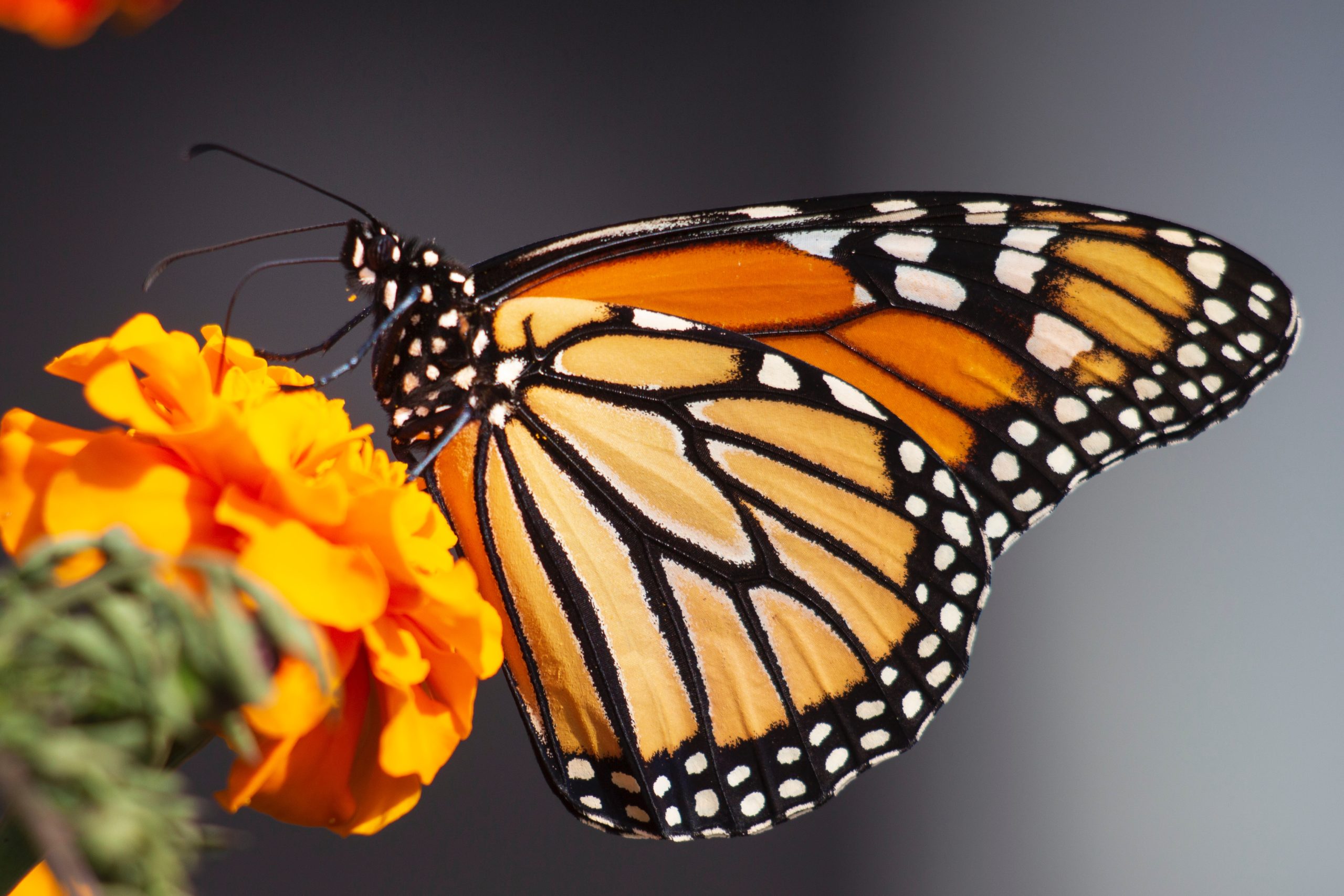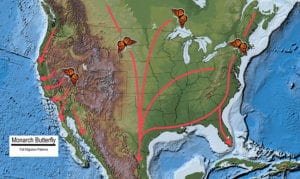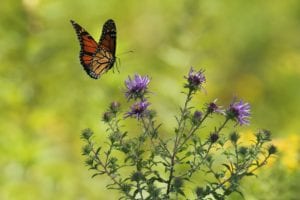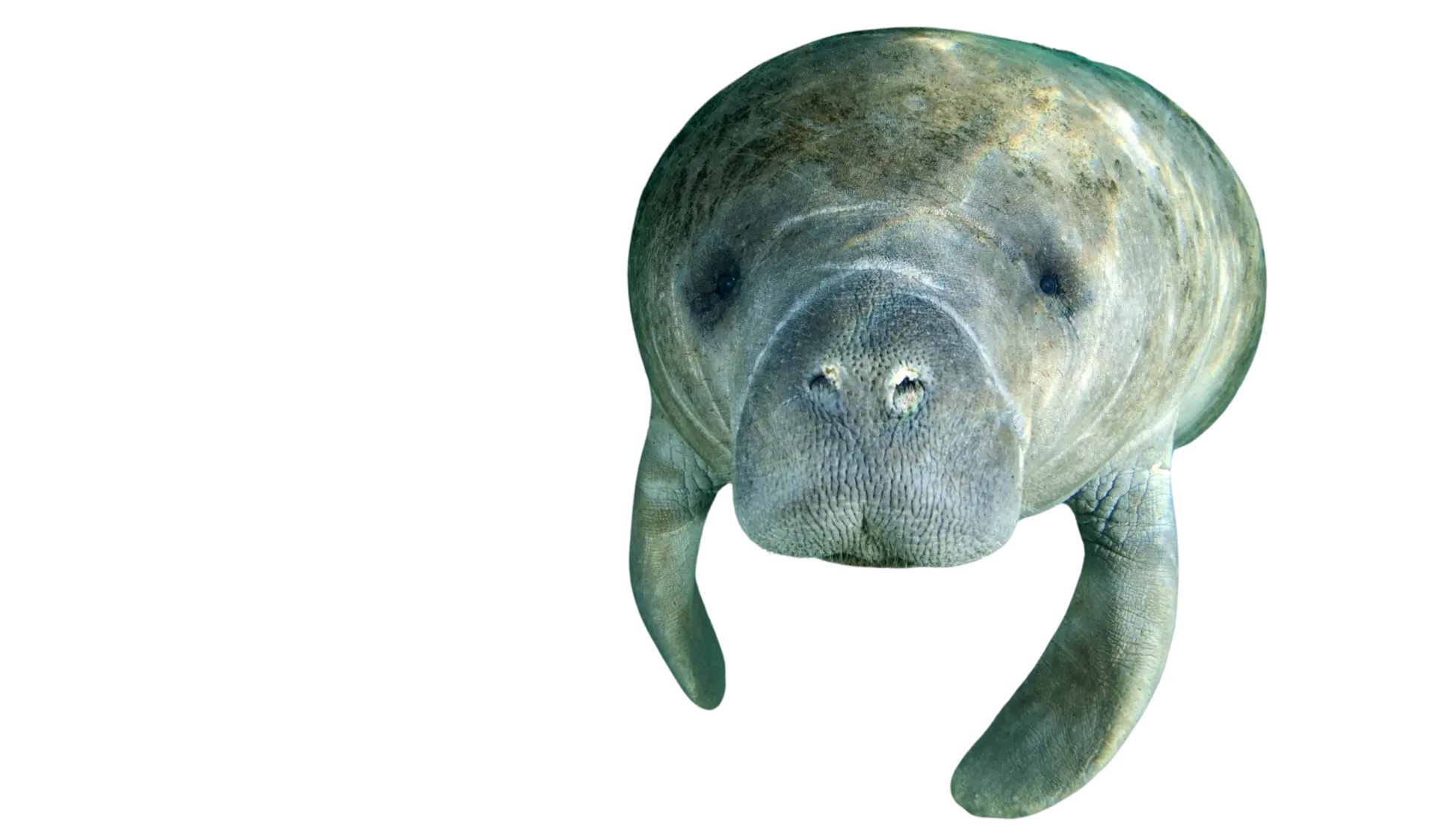 When you think of Texas, what’s the first thing that comes to mind? Football? Oil fields? A good Texas Barbecue joint? How about monarch butterflies (Danaus plexippus)?
When you think of Texas, what’s the first thing that comes to mind? Football? Oil fields? A good Texas Barbecue joint? How about monarch butterflies (Danaus plexippus)?
Yes, monarchs! In fact, Texas is part of the “Miracle Monarch Migration Highway.” Dr. Craig Wilson, director of the USDA Future Scientists Program, & Senior Research Associate, Center for Mathematics and Science Education (CMSE) College of Science, Texas A&M University says monarchs travel 2,000 miles on their migration route, funneling north through Texas in the spring and back in the fall.
“This state is at the epicenter of helping to sustain ‘The Miracle Monarch Migration.’ What we do here is critical, e.g. more milkweed available in the spring for egg laying plus nectar plants for fuel,” says Wilson. “They need more wildflowers and nectar sources in the fall to fuel their flight southwards.”
Wilson and his family take pride in managing a 170-acre ‘nature preserve’ in East Texas. “There is a 7-acre ‘milkweed’ pasture and I have a ‘native milkweed nursery’ to be able to provide seeds to schools. I also provide sprouted milkweed stems to garden clubs.”
The snow and cold weather this spring caused Dr. Wilson to take some extraordinary steps to ensure that monarchs made it through Texas this year, “Since there were no native milkweed plants emerging in our milkweed pasture in East Texas this spring-delayed by the 10-day unprecedented snow and cold- I set out tropical milkweed plants (Asclepias curassavica) in pots, creating an ‘artificial milkweed prairie.’ I was successful in getting egg-laying by monarchs-100s of eggs.”
“Most people mistakenly think that the monarch itself is endangered,” says Wilson, “It is the ‘Miracle Monarch Migration’ that is under threat. The west coast version of the migration has almost stopped, and the Eastern monarch migration is under threat “due to habitat loss, fragmentation and the use of pesticides. It would be a sad outcome for it to end.”

“Monarchs are the only butterfly known to make a two-way migration as birds do. Unlike other butterflies that can overwinter as larvae, pupae, or even as adults in some species, monarchs cannot survive the cold winters of northern climates. Using environmental cues, the monarchs know when it is time to travel south for the winter, using a combination of air currents and thermals to travel long distances.”
That is an amazing feat for something that flies like a drunken sailor. Monarchs in Eastern North America overwinter in the Sierra Madre Mountains in Mexico, specifically on the hillsides of oyamel fir forests. Their western counterpart winter in California. There are several theories about what guides them, but environmental clues start the process.
As the cooler days start hinting at fall weather, they sense it is time to leave on their journey. They ride the air currents south, and they may also use the magnetic pull of the Earth and position of the Sun to help them find the warmer climate.
The Western population is attracted to the eucalyptus, pine and cypress along the California coastline. The eastern “flyways” or migration paths eventually merge, and they find themselves in a huge congregation in Mexico. Fortunately, the Mexican government created the Monarch Butterfly Biosphere Reserve in 1986 and protected the oyamel forests for the butterflies to roost. It is quite a sight to see millions of monarchs roosting together in the oyamel forests, swarming to conserve warmth and rest up to be able to breed the next generation. Each succeeding generation will fly further north until they reach Canada. But no individual monarch completes the entire round trip. An amazing five generations are involved in the annual migration cycle.
Due to their extensive migratory path, international cooperation is also taking place to help the monarch. “Canada, Mexico, and the United States have joined to produce the North American Monarch Conservation Plan (NAMCP), a long-term cooperative agenda to conserve the monarch butterfly and its unique migratory phenomenon.”
According to the U.S. Fish and Wildlife Service, “Scientists know that roughly the entire fall migration season is 85 days – based on first roost reports and arrival dates at overwintering sites in Mexico. Monarchs fly an average of 22 miles a day, traveling only during daylight. Larger monarchs migrate faster than smaller ones. The number of butterflies arriving in their northern breeding range in the summer can highly predict the eventual size of the migration generation.”
The number of monarchs has dwindled significantly over the past few decades. According to the Pollinator Partnership, the monarch population has declined 90% in recent years.
Wilson says, “recent estimates show 105 million monarchs for 2021, down from 141.5 million in 2020 and 300 million in 2019. But he adds that the population has recovered from a record low in 2013-2014 of only 34 million.”
Karen Oberhauser, Co-founder of the Monarch Joint Venture says, “As long as people really work on creating and preserving habitats for monarchs, they have a really good chance of surviving, and the reason that I think that’s true is that they’re a very resilient species.”
We can all play a role in helping monarchs survive and thrive. Wilson says, “It is extremely important that people plant milkweeds in their gardens to make them ‘monarch friendly’ in the spring along with pollinator plants like lantana and verbena for both spring and fall feeding by adult monarchs.”
Plus, there are a lot of opportunities for all of us, no matter where we live in the United States, Mexico, or Southern Canada to help the monarch.
– Mayors’ Monarch Pledge: encourage your local town to commit to becoming monarch friendly.
–Community Scientist: Monarch Joint Venture provides opportunities to be community scientists. By recording and sharing your monarch observations, you can contribute to our understanding of the monarch butterfly migration.
–Classroom Projects: talk to your teacher about getting your class/school involved in studying and conserving monarchs.
-Encourage your local garden shops and big box stores to stock native milkweed plants. If enough of us ask, we might start seeing them on the shelves.
-Monarch Watch: monarchwatch.org/waystations has information on creating Monarch Waystations.
–Journey North allows community scientists to contribute monarch and milkweed data
If we each do just a little to help these fascinating pollinators, we will keep the monarch population healthy, and the Miracle Migration will continue for generations…. of people and monarchs!
Fun Facts about Monarchs:
The caterpillars are keen eaters: They eat 200 times their weight in milkweed!
Monarchs have a slow wing flap rate: The average butterfly flaps its wings around 20 times per second. The Monarch butterfly, on the other hand, flaps its wings around 5 to 12 times a second.
Many different states have the monarch as a symbol: (7) Texas, Illinois, Minnesota, Alabama, Idaho, West Virginia and Vermont.
Monarchs collect Cardenolides (form of steroid) from the milkweed they eat. These Cardiac glycosides (consists of a steroid molecule (cardenolides) attached to a sugar (glycoside)) are used to help people with heart disease.

